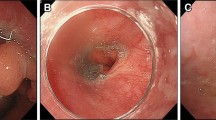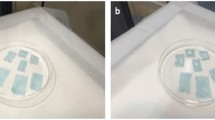Abstract
Objectives
Gastrointestinal (GI) perforations are one of the major adverse events of endoscopic procedures. Polyglycolic acid (PGA) sheets with fibrin glue have been reported to close GI perforations. However, its clinical outcome has not yet been fully investigated; thus, we conducted a multicenter retrospective observational study to assess the efficacy of PGA sheeting for GI perforation.
Methods
The medical records of patients who underwent PGA sheeting for endoscopic GI perforations between April 2013 and March 2018 in 18 Japanese institutions were retrospectively analyzed. PGA sheeting was applied when the clip closure was challenging or failed to use. Perforations were filled with one or several pieces of PGA sheets followed by fibrin glue application through an endoscopic catheter. Nasal or percutaneous drainage and endoscopic clipping were applied as appropriate. Clinical outcomes after PGA sheeting for intraoperative or delayed perforations were separately evaluated.
Results
There were 66 intraoperative and 24 delayed perforation cases. In intraoperative cases, successful closure was attained in 60 cases (91%). The median period from the first sheeting to diet resumption was 6 days (interquartile range [IQR], 4–8.8 days). Large perforation size (≥ 10 mm) and duodenal location showed marginal significant relationship to higher closure failure of intraoperative perforations. In delayed perforation cases, all cases had successful closure. The median period from the first sheeting to diet resumption was 10 days (IQR, 6–37.8 days). No adverse events related to PGA sheeting occurred.
Conclusion
Endoscopic PGA sheeting could be a therapeutic option for GI perforations related to GI endoscopic procedures.


Similar content being viewed by others
References
Minami S, Gotoda T, Ono H, Oda I, Hamanaka H (2006) Complete endoscopic closure of gastric perforation induced by endoscopic resection of early gastric cancer using endoclips can prevent surgery (with video). Gastrointest Endosc 63:596–601
Ono H, Takizawa K, Kakushima N, Tanaka M, Kawata N (2015) Application of polyglycolic acid sheets for delayed perforation after endoscopic submucosal dissection of early gastric cancer. Endoscopy 47 Suppl 1 UCTN:E18–19
Takimoto K, Hagiwara A (2016) Filling and shielding for postoperative gastric perforations of endoscopic submucosal dissection using polyglycolic acid sheets and fibrin glue. Endosc Int open 4:E661-664
Kawai H, Harada K, Ohta H, Tokushima T, Oka S (2012) Prevention of alveolar air leakage after video-assisted thoracic surgery: comparison of the efficacy of methods involving the use of fibrin glue. Thorac Cardiovasc Surg 60:351–355
Sugawara T, Itoh Y, Hirano Y, Higashiyama N, Shimada Y, Kinouchi H, Mizoi K (2005) Novel dural closure technique using polyglactin acid sheet prevents cerebrospinal fluid leakage after spinal surgery. Neurosurgery 57(4):290–294
Takimoto K, Toyonaga T, Matsuyama K (2012) Endoscopic tissue shielding to prevent delayed perforation associated with endoscopic submucosal dissection for duodenal neoplasms. Endoscopy 44 Suppl 2 UCTN:E414–415
Takimoto K, Imai Y, Matsuyama K (2014) Endoscopic tissue shielding method with polyglycolic acid sheets and fibrin glue to prevent delayed perforation after duodenal endoscopic submucosal dissection. Digestive Endosc: Off J Japan Gastroenterol Endosc Society 26(Suppl 2):46–49
Ono S, Tsuji Y, Fujishiro M, Kodashima S, Yamamichi N, Koike K (2014) An effective technique for delivery of polyglycolic acid sheet after endoscopic submucosal dissection of the esophagus: the clip and pull method. Endoscopy 46 Suppl 1 UCTN:E44–45
Tsuji Y, Ohata K, Gunji T, Shozushima M, Hamanaka J, Ohno A, Ito T, Yamamichi N, Fujishiro M, Matsuhashi N, Koike K (2014) Endoscopic tissue shielding method with polyglycolic acid sheets and fibrin glue to cover wounds after colorectal endoscopic submucosal dissection (with video). Gastrointest Endosc 79:151–155
Sakaguchi Y, Tsuji Y, Yamamichi N, Fujishiro M, Koike K (2016) Successful closure of a large perforation during colorectal endoscopic submucosal dissection by application of polyglycolic acid sheets and fibrin glue. Gastrointest Endosc 84:374–375
Tsuji Y, Fujishiro M, Kodashima S, Ono S, Niimi K, Mochizuki S, Asada-Hirayama I, Matsuda R, Minatsuki C, Nakayama C, Takahashi Y, Sakaguchi Y, Yamamichi N, Koike K (2015) Polyglycolic acid sheets and fibrin glue decrease the risk of bleeding after endoscopic submucosal dissection of gastric neoplasms (with video). Gastrointest Endosc 81:906–912
Kawata N, Ono H, Takizawa K, Kakushima N, Tanaka M, Igarashi K, Yoshida M, Kishida Y, Iwai T, Ito S, Imai K, Hotta K, Ishiwatari H, Matsubayashi H (2018) Efficacy of polyglycolic acid sheets and fibrin glue for prevention of bleeding after gastric endoscopic submucosal dissection in patients under continued antithrombotic agents. Gastric Cancer: Off J Int Gastric Cancer Assoc Japanese Gastric Cancer Assoc 21:696–702
Hatamori H, Yoshio T, Tokai Y, Namikawa K, Yoshimizu S, Horiuchi Y, Tsuchida T, Ishiyama A, Hirasawa T, Kanamori J, Okamura A, Imamura Y, Watanabe M, Fujisaki J (2021) Efficacy of endoscopic filling with polyglycolic acid sheets and fibrin glue for anastomotic leak after esophageal cancer surgery: identification of an optimal technique. Esophagus 18(3):529–536
Haito-Chavez Y, Law JK, Kratt T, Arezzo A, Verra M, Morino M, Sharaiha RZ, Poley JW, Kahaleh M, Thompson CC, Ryan MB, Choksi N, Elmunzer BJ, Gosain S, Goldberg EM, Modayil RJ, Stavropoulos SN, Schembre DB, DiMaio CJ, Chandrasekhara V, Hasan MK, Varadarajulu S, Hawes R, Gomez V, Woodward TA, Rubel-Cohen S, Fluxa F, Vleggaar FP, Akshintala VS, Raju GS, Khashab MA (2014) International multicenter experience with an over-the-scope clipping device for endoscopic management of GI defects (with video). Gastrointest Endosc 80:610–622
Ono H, Tanaka M, Takizawa K, Kakushima N, Kawata N, Imai K, Hotta K, Matsubayashi H (2015) Utility of the over-the-scope-clip system for treating a large esophageal perforation. Esophagus 12:336–339
John A, Chowdhury SD, Kurien RT, David D, Dutta AK, Simon EG, Abraham V, Joseph AJ, Samarasam I (2020) Self-expanding metal stent in esophageal perforations and anastomotic leaks. Indian J Gastroenterol: official J Indian Society of Gastroenterol 39:445–449
Endo M, Inomata M, Terui T, Oana S, Kudara N, Obara H, Hashimoto Y (2004) New endoscopic technique to close large mucosal defects after endoscopic mucosal resection in patients with gastric mucosal tumors. Digestive Endosc: Off J Japan Gastroenterol Endosc Society 16:372–375
Ye LP, Yu Z, Mao XL, Zhu LH, Zhou XB (2014) Endoscopic full-thickness resection with defect closure using clips and an endoloop for gastric subepithelial tumors arising from the muscularis propria. Surg Endosc 28:1978–1983
Zhang Y, Wang X, Xiong G, Qian Y, Wang H, Liu L, Miao L, Fan Z (2014) Complete defect closure of gastric submucosal tumors with purse-string sutures. Surg Endosc 28:1844–1851
Kantsevoy SV, Bitner M, Mitrakov AA, Thuluvath PJ (2014) Endoscopic suturing closure of large mucosal defects after endoscopic submucosal dissection is technically feasible, fast, and eliminates the need for hospitalization (with videos). Gastrointest Endosc 79:503–507
Li CH, Bair MJ, Chang WH, Shih SC, Lin SC, Yeh CY (2009) Predictive model for length of hospital stay of patients surviving surgery for perforated peptic ulcer. Journal of the Formosan Medical Association = Taiwan yi zhi 108:644–652
Funding
No funding was received.
Author information
Authors and Affiliations
Consortia
Contributions
KT, NM, YN, YT, YT, KT, YM, YN, KH, HA, NY, HA, TM, TI, HS, KY, HS, TM, HN, and HM collected the data. KT, NM, YN, YT, YT, KT, YM, YN, KH, HA, NY, HA, TM, TI, HS, KY, HS, TM, HN, HK, YT and HO assisted with data analysis and interpretation. YT planned and conducted the study. KT drafted the manuscript. All authors participated in the preparation of the report and approved the final version.
Corresponding author
Ethics declarations
Disclosures
Dr. Yosuke Tsuji had research grant from GUNZE, received study material (Neoveil), and study drug (Beriplast) from GUNZE and CSL Behring, respectively. Dr. Shinichiro Hori received honoraria for lectures from Fujifilm, Kaneka Medix, and Japan Gastroenterological Endoscopy Society. Dr. Yoji Takeuchi received honoraria for lectures from Olympus, Boston Scientific Japan, Daiichi-Sankyo, Miyarisan Pharmaceutical, Asuka Pharmaceutical, AstraZeneca, EA Pharma, Zeria Pharmaceutical, Fujifilm, Kaneka Medix, Kyorin Pharmaceutical, and Japan Gastroenterological Endoscopy Society. Hiroyuki Ono received honoraria for lectures from Olympus, AstraZeneca, EA Pharma, and Daiichi-Sankyo. Drs. Kengo Takimoto, Noriko Matsuura, Yoshiko Nakano, Kohei Takizawa, Yoshinori Morita, Yasuaki Nagami, Kingo Hirasawa, Hiroshi Araki, Naoyuki Yamaguchi, Hiroyuki Aoyagi, Tamotsu Matsuhashi, Toshiro Iizuka, Hisanobu Saegusa, Kenji Yamazaki, Tomohiko Mannami, Noboru Hanaoka, Hirohito Mori, and Hideki Kobara have no conflict of interest or financial ties to disclose.
Additional information
Publisher's Note
Springer Nature remains neutral with regard to jurisdictional claims in published maps and institutional affiliations.
Rights and permissions
About this article
Cite this article
Takimoto, K., Matsuura, N., Nakano, Y. et al. Efficacy of polyglycolic acid sheeting with fibrin glue for perforations related to gastrointestinal endoscopic procedures: a multicenter retrospective cohort study. Surg Endosc 36, 5084–5093 (2022). https://doi.org/10.1007/s00464-021-08873-5
Received:
Accepted:
Published:
Issue Date:
DOI: https://doi.org/10.1007/s00464-021-08873-5




